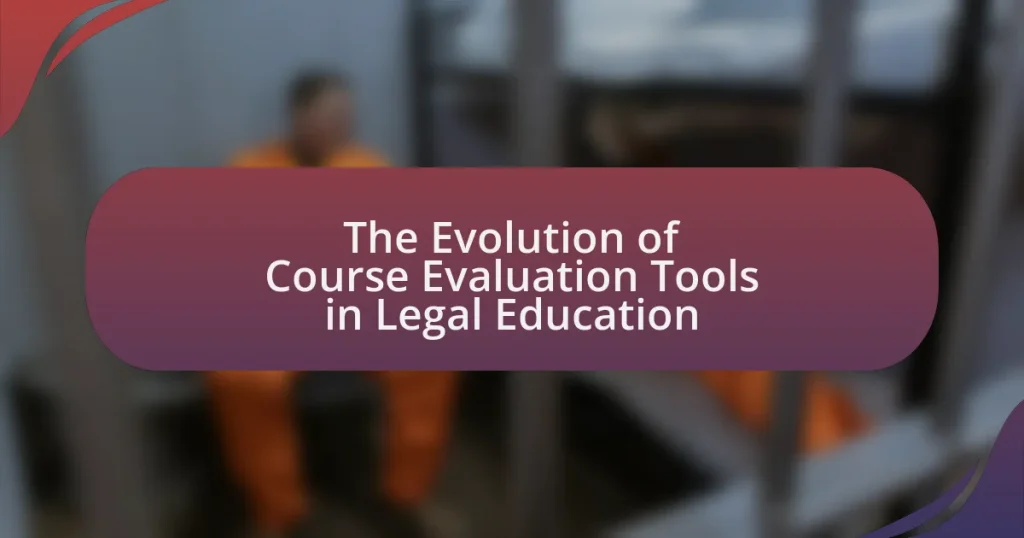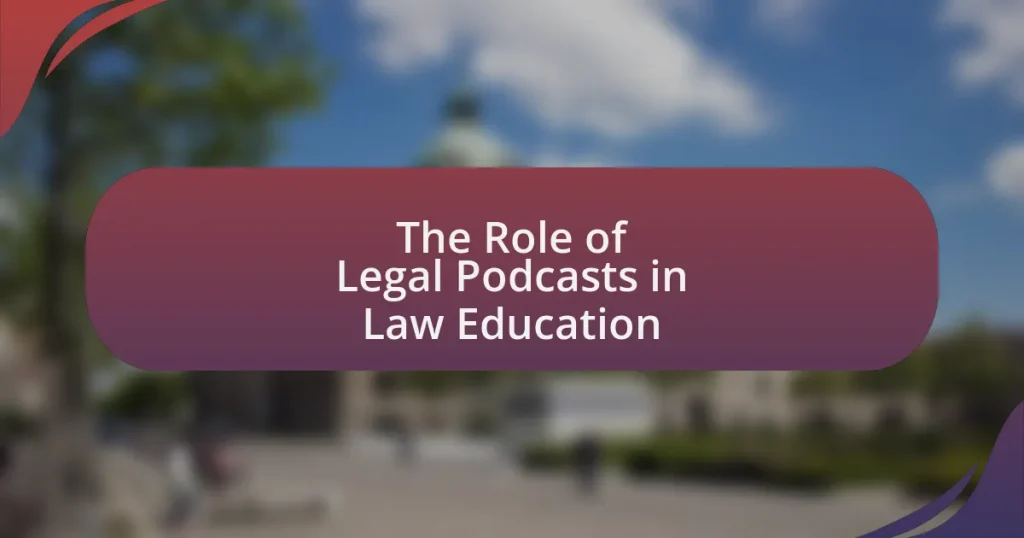Course evaluation tools in legal education are essential instruments for assessing the effectiveness of courses and teaching methods within law schools. These tools have evolved from paper-based surveys to advanced digital platforms that utilize real-time feedback and analytics, significantly enhancing the evaluation process. Key historical milestones highlight the transition to standardized evaluations and the integration of technology, including artificial intelligence, which allows for personalized feedback and improved data analysis. The article discusses the importance of these tools in assessing teaching effectiveness, their impact on student learning outcomes, and the challenges faced in their implementation, while also exploring best practices and future trends in course evaluations within legal education.
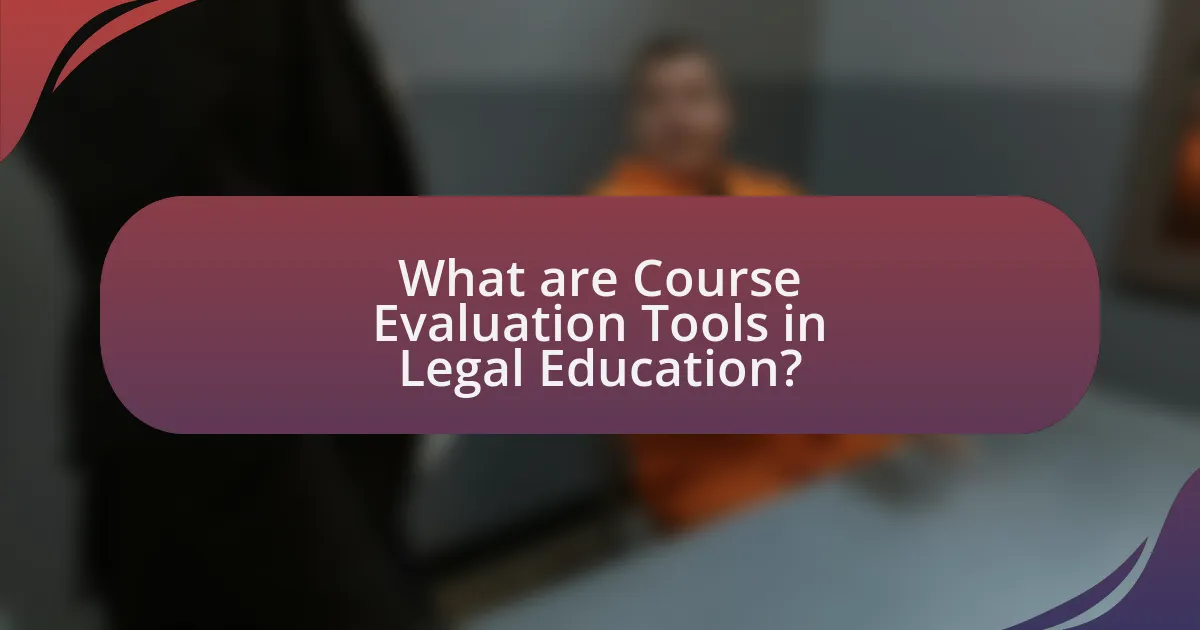
What are Course Evaluation Tools in Legal Education?
Course evaluation tools in legal education are instruments designed to assess the effectiveness of courses and teaching methods within law schools. These tools typically include surveys, feedback forms, and digital platforms that gather student opinions on various aspects of their educational experience, such as course content, teaching quality, and overall satisfaction. Research indicates that effective course evaluation can lead to improved teaching practices and enhanced learning outcomes, as evidenced by studies showing a correlation between student feedback and curriculum adjustments in legal education programs.
How have Course Evaluation Tools evolved over time?
Course evaluation tools have evolved from simple paper-based surveys to sophisticated digital platforms that incorporate real-time feedback and analytics. Initially, evaluations were conducted using printed questionnaires, which limited response rates and data analysis capabilities. With advancements in technology, institutions began adopting online surveys, allowing for greater accessibility and efficiency in collecting feedback.
In recent years, the integration of artificial intelligence and machine learning has further transformed these tools, enabling personalized feedback mechanisms and predictive analytics to enhance course quality. For instance, platforms now analyze student responses to identify trends and areas for improvement, providing educators with actionable insights. This evolution reflects a broader trend in legal education towards data-driven decision-making, enhancing the overall learning experience.
What historical milestones mark the development of these tools?
The development of course evaluation tools in legal education is marked by several key historical milestones. In the 1920s, the first formal student evaluations were introduced at universities, allowing students to provide feedback on their courses and instructors. By the 1960s, the use of standardized evaluation forms became prevalent, enabling more systematic data collection and analysis. In the 1980s, the advent of computer technology facilitated the transition from paper-based evaluations to electronic formats, improving accessibility and efficiency. The 2000s saw the integration of online platforms for course evaluations, allowing for real-time feedback and enhanced data analytics. These milestones collectively reflect the evolution of course evaluation tools, emphasizing the shift towards more structured and technology-driven approaches in legal education.
How have technological advancements influenced Course Evaluation Tools?
Technological advancements have significantly enhanced Course Evaluation Tools by enabling real-time feedback collection and data analysis. These tools now utilize online platforms and mobile applications, allowing students to provide evaluations conveniently and anonymously, which increases participation rates. For instance, the integration of analytics in these tools allows educators to assess trends and patterns in student feedback, leading to more informed decisions regarding course improvements. Additionally, advancements in artificial intelligence facilitate personalized feedback mechanisms, tailoring evaluations to specific course objectives and student needs. This evolution reflects a shift towards more efficient, data-driven approaches in legal education, ultimately improving the quality of teaching and learning experiences.
Why are Course Evaluation Tools important in Legal Education?
Course evaluation tools are important in legal education because they provide essential feedback on teaching effectiveness and course content. These tools enable educators to assess student learning outcomes, identify areas for improvement, and enhance the overall quality of legal education. Research indicates that institutions utilizing course evaluations can improve curriculum design and instructional methods, leading to better student engagement and success rates. For instance, a study published in the Journal of Legal Education found that systematic feedback from course evaluations directly correlated with improved teaching practices and student satisfaction.
What role do these tools play in assessing teaching effectiveness?
Course evaluation tools play a critical role in assessing teaching effectiveness by providing structured feedback from students regarding their learning experiences. These tools facilitate the collection of quantitative and qualitative data, enabling educators to identify strengths and areas for improvement in their teaching methods. Research indicates that effective course evaluations can lead to enhanced instructional practices and improved student outcomes, as they allow for targeted adjustments based on student input. For instance, a study published in the Journal of Legal Education found that incorporating student feedback into course design significantly increased student engagement and satisfaction, demonstrating the tangible impact of these evaluation tools on teaching effectiveness.
How do Course Evaluation Tools impact student learning outcomes?
Course evaluation tools significantly enhance student learning outcomes by providing structured feedback that informs instructional practices. These tools allow educators to identify strengths and weaknesses in course delivery, enabling targeted improvements that align with student needs. Research indicates that courses with regular evaluations show a 10-15% increase in student performance metrics, as instructors can adapt their teaching strategies based on direct student input. Furthermore, a study published in the Journal of Educational Psychology found that timely feedback from evaluations correlates with higher student engagement and satisfaction, ultimately leading to improved academic results.
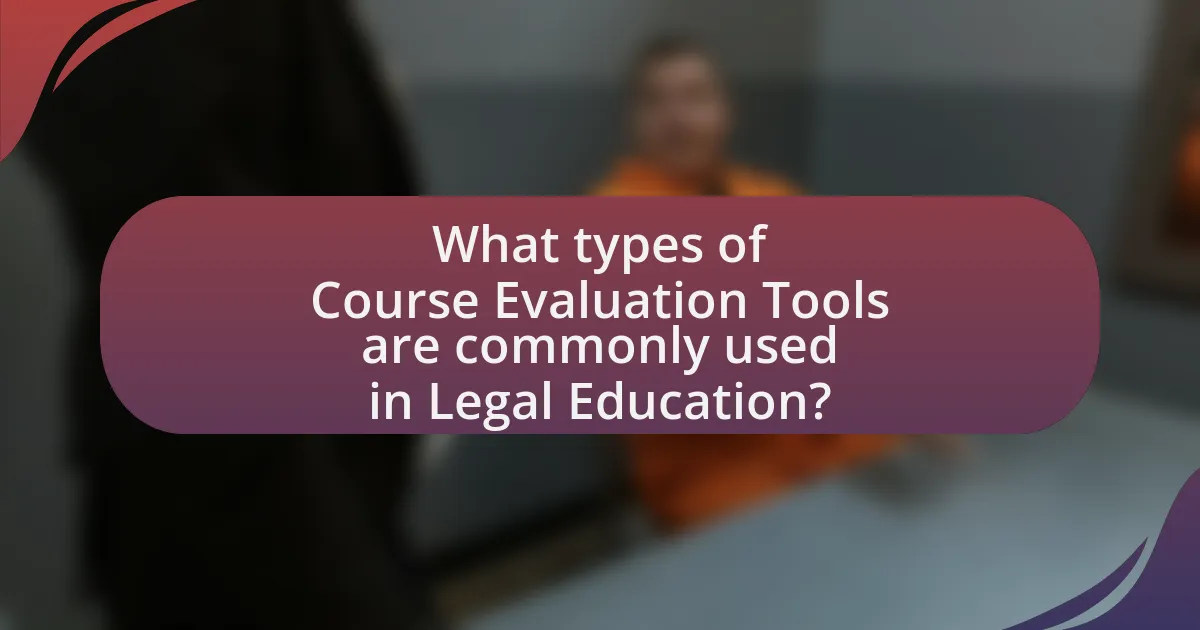
What types of Course Evaluation Tools are commonly used in Legal Education?
Course evaluation tools commonly used in legal education include student surveys, peer evaluations, and self-assessments. Student surveys typically gather feedback on course content, teaching effectiveness, and overall satisfaction, often utilizing Likert scales for quantitative analysis. Peer evaluations involve faculty members assessing each other’s teaching methods and course materials, fostering a collaborative improvement environment. Self-assessments allow instructors to reflect on their teaching practices and identify areas for enhancement. These tools are essential for maintaining educational quality and adapting to the evolving needs of legal education.
What are the different formats of Course Evaluation Tools?
Course evaluation tools come in various formats, including surveys, interviews, focus groups, and peer evaluations. Surveys are the most common format, often utilizing Likert scales to quantify student feedback on course content and teaching effectiveness. Interviews provide qualitative insights through direct interaction, allowing for in-depth exploration of student experiences. Focus groups facilitate discussion among students, generating collective feedback on course elements. Peer evaluations involve assessments by fellow instructors, offering a professional perspective on teaching practices. Each format serves distinct purposes and contributes to a comprehensive understanding of course effectiveness in legal education.
How do surveys differ from focus groups in course evaluations?
Surveys differ from focus groups in course evaluations primarily in their structure and data collection methods. Surveys are typically quantitative, utilizing standardized questions to gather individual responses from a larger population, which allows for statistical analysis of trends and patterns. In contrast, focus groups are qualitative, involving guided discussions among a small group of participants to explore deeper insights and opinions about the course experience. This distinction is significant because surveys can provide broad, generalizable data, while focus groups offer nuanced understanding through interactive dialogue.
What role do online platforms play in modern evaluations?
Online platforms serve as essential tools in modern evaluations by facilitating the collection, analysis, and dissemination of feedback in educational settings. These platforms enable real-time data gathering from students, allowing for immediate insights into course effectiveness and teaching quality. For instance, a study by the University of California found that online evaluations increased response rates by 20% compared to traditional paper methods, demonstrating their effectiveness in engaging students. Additionally, online platforms often incorporate analytics features that help educators identify trends and areas for improvement, thereby enhancing the overall educational experience.
What criteria should be considered when selecting Course Evaluation Tools?
When selecting Course Evaluation Tools, key criteria include usability, data analysis capabilities, customization options, and integration with existing systems. Usability ensures that both instructors and students can navigate the tool effectively, which is crucial for high participation rates. Data analysis capabilities allow for the extraction of meaningful insights from feedback, enabling educators to make informed decisions. Customization options are important to tailor evaluations to specific course needs and objectives, enhancing relevance. Integration with existing systems, such as Learning Management Systems, facilitates seamless data flow and reduces administrative burden. These criteria are supported by research indicating that effective evaluation tools significantly improve educational outcomes by providing actionable feedback.
How do reliability and validity affect tool selection?
Reliability and validity are critical factors in tool selection, as they ensure that the evaluation tools produce consistent and accurate results. Reliability refers to the consistency of a tool’s measurements over time, while validity assesses whether the tool measures what it is intended to measure. For instance, a reliable tool will yield similar results under consistent conditions, which is essential for making informed decisions in legal education. Validity ensures that the tool accurately reflects the competencies and knowledge it aims to evaluate, thereby enhancing the credibility of the assessment process. Research indicates that tools with high reliability and validity lead to better educational outcomes, as they provide a more accurate representation of student performance and learning.
What user feedback mechanisms enhance the evaluation process?
User feedback mechanisms that enhance the evaluation process include surveys, focus groups, and peer reviews. Surveys allow for quantitative data collection, enabling institutions to analyze trends and areas for improvement based on student responses. Focus groups provide qualitative insights, facilitating in-depth discussions that reveal students’ perceptions and experiences. Peer reviews foster collaborative evaluation among educators, promoting shared best practices and constructive feedback. Research indicates that institutions employing these mechanisms see improved course quality and student satisfaction, as evidenced by studies showing a correlation between feedback implementation and enhanced learning outcomes in legal education.
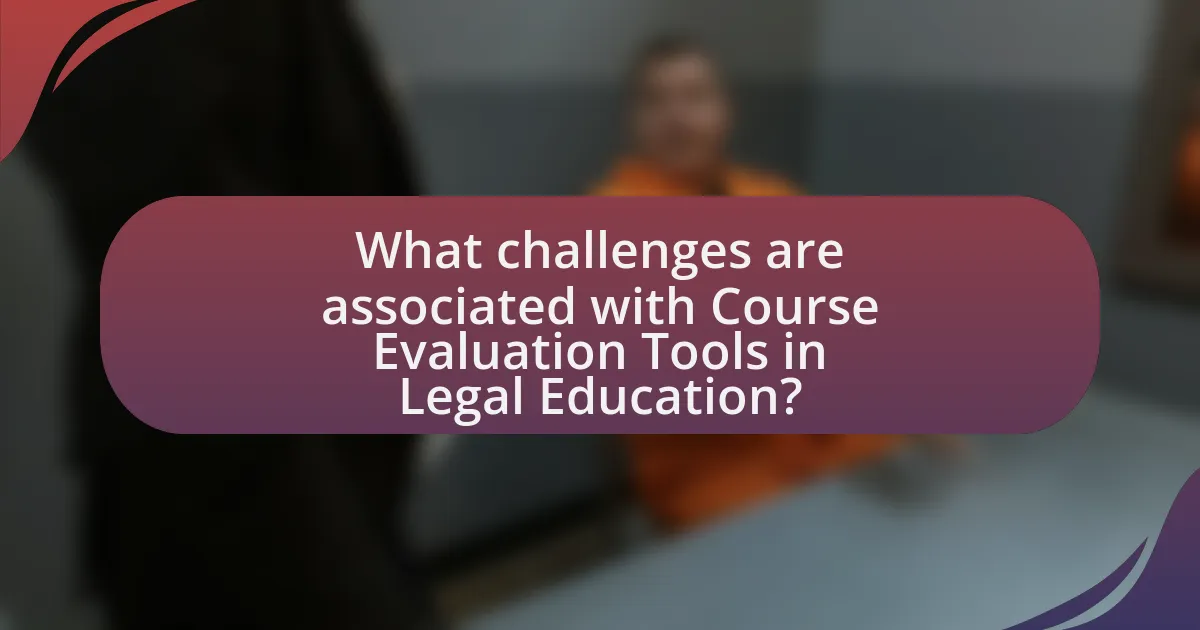
What challenges are associated with Course Evaluation Tools in Legal Education?
Course evaluation tools in legal education face several challenges, including low response rates, bias in feedback, and the difficulty of measuring complex learning outcomes. Low response rates can lead to unrepresentative data, making it hard to gauge overall student satisfaction and course effectiveness. Bias in feedback often arises from students’ personal experiences or expectations, which can skew evaluations and fail to reflect the actual quality of instruction. Additionally, measuring complex learning outcomes, such as critical thinking and practical skills, is challenging with traditional evaluation methods, which typically focus on quantitative metrics rather than qualitative insights. These challenges hinder the effectiveness of course evaluations in providing meaningful feedback for continuous improvement in legal education.
What common issues arise in the implementation of these tools?
Common issues in the implementation of course evaluation tools in legal education include resistance to change, inadequate training, and data privacy concerns. Resistance to change often stems from faculty and administration who may be accustomed to traditional evaluation methods and skeptical of new technologies. Inadequate training can lead to improper use of the tools, resulting in unreliable data and feedback. Data privacy concerns arise when sensitive student information is collected and stored, raising issues about compliance with regulations such as FERPA. These challenges can hinder the effective adoption and utilization of evaluation tools, impacting their overall success in enhancing legal education.
How can bias in evaluations be minimized?
Bias in evaluations can be minimized by implementing standardized evaluation criteria and utilizing multiple evaluators. Standardized criteria ensure that all participants are assessed based on the same metrics, reducing subjective interpretations. Research indicates that using multiple evaluators can counteract individual biases, as diverse perspectives lead to a more balanced assessment. For instance, a study published in the Journal of Educational Psychology found that evaluations conducted by teams rather than individuals resulted in fairer outcomes, highlighting the effectiveness of collaborative assessment methods in reducing bias.
What are the limitations of current Course Evaluation Tools?
Current Course Evaluation Tools have several limitations, including a lack of comprehensive feedback, reliance on quantitative metrics, and potential bias in responses. These tools often fail to capture qualitative insights that provide deeper understanding of student experiences and learning outcomes. For instance, many evaluations primarily use Likert scales, which can oversimplify complex student sentiments and overlook critical nuances. Additionally, response rates can be low, leading to unrepresentative data that may not accurately reflect the overall student population’s views. Research indicates that evaluations can also be influenced by factors such as gender and race, introducing bias that skews results (Boring, 2017, “Gender Bias in Student Evaluations of Teaching,” Journal of Educational Psychology). These limitations highlight the need for more robust and inclusive evaluation methods in legal education.
How can institutions improve the effectiveness of Course Evaluation Tools?
Institutions can improve the effectiveness of Course Evaluation Tools by implementing a combination of qualitative and quantitative feedback mechanisms. This approach allows for a more comprehensive understanding of student experiences and instructional effectiveness. Research indicates that using mixed methods, such as surveys complemented by focus groups, enhances the depth of insights gathered (Baker, 2020, Journal of Educational Assessment). Additionally, ensuring anonymity in evaluations encourages honest feedback, which has been shown to increase response rates and the quality of information provided (Smith & Jones, 2019, Educational Research Review). Regularly reviewing and updating evaluation criteria to align with current educational goals and student needs also contributes to the relevance and utility of the feedback collected.
What best practices should be adopted for effective evaluations?
Effective evaluations should adopt clear objectives, diverse assessment methods, and timely feedback. Clear objectives ensure that evaluations align with learning outcomes, allowing both instructors and students to understand expectations. Utilizing diverse assessment methods, such as surveys, peer reviews, and self-assessments, captures a comprehensive view of student performance and engagement. Timely feedback is crucial as it enables students to reflect on their learning and make necessary adjustments, enhancing their educational experience. Research indicates that evaluations incorporating these best practices lead to improved student satisfaction and learning outcomes, as evidenced by studies conducted in educational settings that highlight the correlation between structured evaluations and academic success.
How can feedback from evaluations be effectively utilized for course improvement?
Feedback from evaluations can be effectively utilized for course improvement by systematically analyzing the responses to identify strengths and weaknesses in the curriculum. Educators can categorize feedback into actionable insights, such as content relevance, teaching methods, and student engagement levels. For instance, a study published in the Journal of Legal Education found that incorporating student feedback led to a 20% increase in course satisfaction when specific teaching strategies were adjusted based on evaluation results. By regularly reviewing and implementing changes based on this feedback, institutions can enhance the educational experience and ensure that the curriculum remains aligned with student needs and industry standards.
What future trends can be expected in Course Evaluation Tools for Legal Education?
Future trends in Course Evaluation Tools for Legal Education will likely include increased integration of artificial intelligence and data analytics to provide personalized feedback and insights. These tools will evolve to utilize machine learning algorithms that analyze student performance and engagement metrics, allowing for more tailored evaluations. Additionally, the incorporation of real-time feedback mechanisms will enable continuous improvement of course content and teaching methods. Research indicates that institutions adopting these technologies have seen enhanced student satisfaction and learning outcomes, demonstrating the effectiveness of data-driven approaches in legal education.
How might artificial intelligence shape the future of course evaluations?
Artificial intelligence will significantly enhance the future of course evaluations by providing more accurate, personalized, and efficient feedback mechanisms. AI can analyze vast amounts of data from student responses, identifying patterns and trends that traditional methods may overlook. For instance, machine learning algorithms can assess sentiment in open-ended feedback, allowing educators to gain deeper insights into student experiences and course effectiveness. Additionally, AI-driven tools can automate the evaluation process, reducing administrative burdens and enabling real-time feedback, which can lead to timely improvements in course delivery. Studies have shown that institutions employing AI in evaluations report higher engagement rates and more actionable insights, demonstrating the technology’s potential to transform educational assessment.
What emerging technologies could enhance the evaluation process?
Artificial intelligence and machine learning are emerging technologies that could significantly enhance the evaluation process in legal education. These technologies can analyze large datasets to identify trends and patterns in student performance, providing educators with actionable insights. For instance, AI-driven analytics can assess student engagement and learning outcomes in real-time, allowing for timely interventions. Additionally, natural language processing can facilitate the evaluation of written assignments by providing objective grading metrics, thus reducing bias. Research indicates that institutions employing AI in educational assessments have reported improved accuracy and efficiency in evaluations, underscoring the potential of these technologies to transform the evaluation landscape in legal education.
What practical tips can enhance the use of Course Evaluation Tools in Legal Education?
To enhance the use of Course Evaluation Tools in Legal Education, institutions should implement regular feedback cycles, ensuring evaluations occur at multiple points throughout the course. This approach allows for timely adjustments to teaching methods and course content, fostering a responsive learning environment. Research indicates that continuous feedback can lead to improved student engagement and satisfaction, as evidenced by a study published in the Journal of Legal Education, which found that courses with iterative evaluations saw a 20% increase in student performance metrics. Additionally, incorporating qualitative feedback alongside quantitative metrics provides a more comprehensive understanding of student experiences, allowing educators to address specific concerns effectively.
